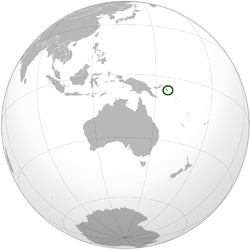Republic of the North Solomons
| Republic of the North Solomons (1975–1976) Bougainville Interim Government (1990–1998) | |||||
| Unrecognized state | |||||
| |||||
|
| |||||
 | |||||
| Capital | Buka | ||||
| Government | Republic | ||||
| President | |||||
| - | 1975–1976 | Alexis Sarei | |||
| - | 1990–1998 | Francis Ona | |||
| History | |||||
| - | Declared[1] | 11 September 1975 | |||
| - | Provincial status in Papua New Guinea | 1976 | |||
| - | Independence | 17 May 1990 | |||
| - | Reintegrated[1] into Papua New Guinea | 23 January 1998 | |||
The Republic of the North Solomons (also known as the Republic of North Solomons or North Solomons Republic) was an unrecognised state that existed for about six months in what is now the Autonomous Region of Bougainville, Papua New Guinea (PNG).
On 1 September 1975,[1] the North Solomons unilaterally declared independence from the Australian-administered territory of Papua and New Guinea, which itself was due to become independent on 16 September.
Reaction
Papua New Guinea's Chief Minister, Mr Michael Somare, initially showed no outward concern at Bougainville's stand. The Roman Catholic Church, the most powerful organization in Bougainville, officially announced its support for the breakaway move. (Bougainvilleans have experienced German, British, and Australian colonial administrations and missionaries.) Papua New Guinea, Australia and the United Nations did not recognize the secession and PNG government officials on the island simply ignored it. Through their district council, the Western Islands District of the British Solomon Islands Protectorate – comprising a third of the population of the Solomon Islands – asked to join independent Bougainville.
Context
The Bougainville islanders have always regarded themselves as a separate entity in Papua New Guinea. The people have very dark skin in contrast to the lighter skin colour of Papuans. The island is 1,000 kilometres east of the mainland and, geographically, is nearer the Solomon Islands, forming part of the Solomon Islands archipelago.
The declaration of independence followed the discovery sometime previously of the world's largest deposits of copper in the region. The Papua New Guinea Government had then established the Bougainville Copper mine company in Panguna, central Bougainville. Bougainville Copper was a subsidiary of Conzinc Rio Tinto of Australia, which in turn was controlled by the British company Rio Tinto Group. When the mining started, the Australia administration, backed by armed police, gave access to prospectors while informing residents that their land was being taken over without discussion.
Bougainville rejoined Papua New Guinea as the Autonomous Region of Bougainville early in 1976.
Civil war
Secession was revived in 1990, under the name of the Bougainville Interim Government, by Francis Ona and the Bougainville Revolutionary Army. Although these groups' grievances were based on the activities of Bougainville Copper, the conflict eventually descended into a civil war along tribal lines. By the time peace was negotiated in 1998, the conflict had taken between 15,000 and 20,000 lives.[2][3]
References
- ↑ 1.0 1.1 1.2 Chronology of Bougainville Civil War
- ↑ Saovana-Spriggs, Ruth (2000). "Christianity and women in Bougainville" (PDF). Development Bulletin (51): 58–60. Retrieved 2007-10-11.
- ↑ "EU Relations with Papua New Guinea". European Commission. Retrieved 2007-10-11.
